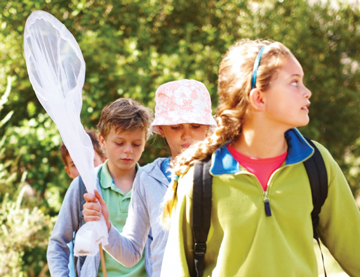Banner Image

We’ve all felt it. That connection and oneness with nature that fills you with a sense of wonder and awe.
Research suggests that people who are more connected to nature are more likely to protect our environment, and children who are more connected to nature experience a better sense of wellbeing.
So what effect did the rolling and relentless COVID-19 lockdowns have on our children’s connection to nature – given that many of them were stuck indoors for weeks on end and couldn’t take part in outdoor school activities, school excursions and school camps?
That’s the question a team of UK researchers wanted to know when they surveyed 372 families of young children aged between three and seven years old in a recent study.
Parents were asked about parent and child relationships and wellbeing; if their child’s connection to nature had changed (and in what way); and their child’s emotions and behaviours.
Nearly two thirds of parents reported a change – most typically, an increase – in their child’s connection to nature.
“Explanations for this increase included having more time, increased enjoyment of nature, and increased awareness or interest in nature,” the research team, led by Samantha Friedman from the Centre for Family Research at the University of Cambridge, concluded.
The authors said the one third of children whose connection to nature decreased during the pandemic displayed increased problems of wellbeing, manifesting as either ‘acting out’ (externalising problems) or sadness/anxiety (internalising problems).
The research – published in People and Nature science journal – found that children who experienced an increased connection to nature also experienced fewer emotional and behavioural problems.
“Given that we know it’s important to increase connection to nature to encourage pro-environmental behaviours and ensure that children are experiencing the wellbeing benefits, we feel that efforts should be made to maintain this increased connection during possible future waves of the pandemic as well as after lockdowns and COVID-19 are a distant memory,” the authors said.
Now that we understand how children respond to nature connection and why, how can we shape our post-pandemic world to increase connection to nature?
One way of doing this is to harness nature, and its inherent benefits, into school activities, school excursions and school camps – albeit in a COVID-friendly, physically-distanced way.
The following ‘nature exploration’ ideas come from an article published by healthychildren.org, and could easily be incorporated into your next school excursion, school activity or school camp:
- Nature sculptures can be built with twigs, leaves, cones, rocks and more by sticking the collected items into a playdough base.
- Take story time outside. Grab a rug, some books and a shady spot and start reading! Pick books about nature to help children make connections.
- Hold a nature scavenger hunt.
- Start a nature collection.
- Leave a nature trail and send students on a ‘secret spy mission’.
Getting students out and into nature provides more than a fun break – it’s also good for their physical and mental health and development, and starts a life-long connection to – and care of – nature.
Sources:
British Ecological Society, People and Nature. Published October 2021. You can read the study here: https://besjournals.onlinelibrary.wiley.com/doi/full/10.1002/pan3.10270
Healthychildren.org: https://www.healthychildren.org/English/health-issues/conditions/COVID-19/Pages/Getting-Children-and-Teens-Outside-While-Social-Distancing.aspx
